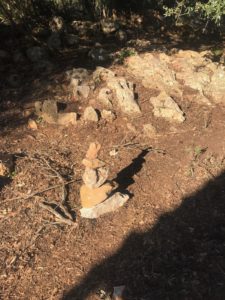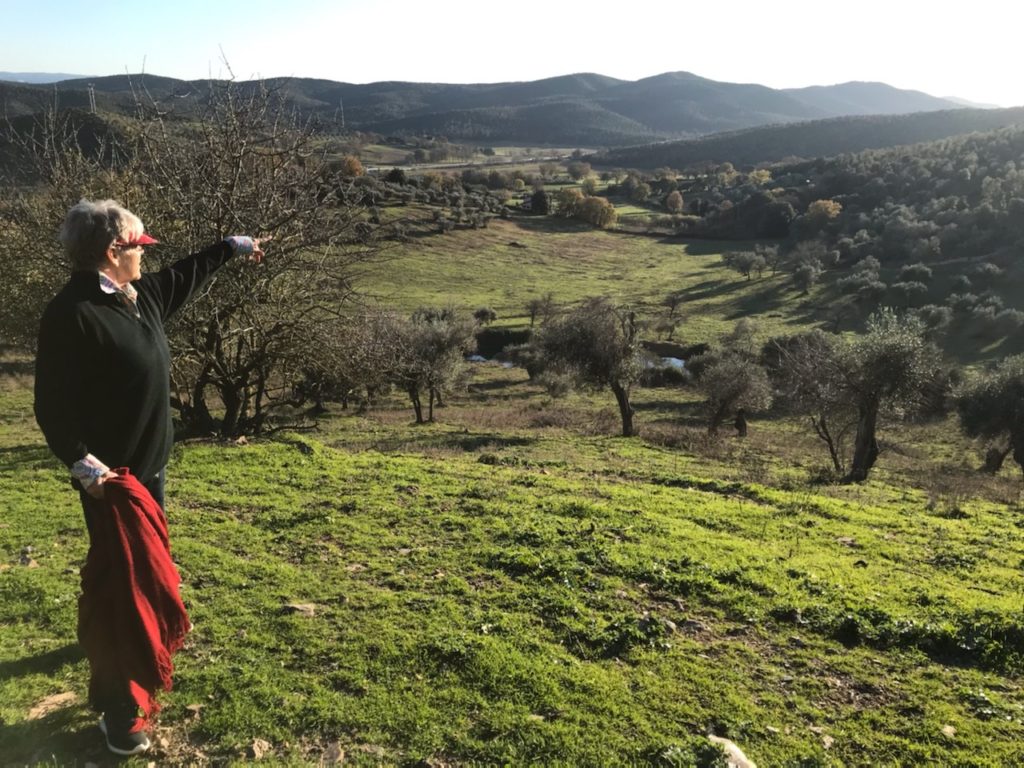Editor’s note – When O’Brien started writing columns for GreeneCountyNewsOnline when in launched in 2013, she declined to offer a photo to use at the top of her columns. She has finally sent along a photo of herself in Italy, where she is enjoying a few weeks of respite from issues that worry conscientious liberals.
~a column by Colleen O’Brien
I have named it The Great Rocky Road. It is the means by which we get to the casita on the hill overlooking the meadow where my hosts live. Calling the pathway a “road” is hyperbole; it is a trail about 10 feet wide the length of about five or six blocks of winding, twisting inclines, declines, up-and-down little hills covered with pebbles, rocks and small boulders. The ruts from running water are like ravines looking to swallow small cars.
There are two gates to open, one manually, and then the final luge-like run to the parking area in front of the casita—a gravitational pull a little like the feeling you get on a roller coaster.
Just walking the road, which I do every morning for exercise, is difficult because of the rocks and small boulders. If I want to look at the view, I have to stop; if I don’t keep on eye on where my feet are landing, I’ll be a goner, bouncing down The Great Rocky like one more loose boulder.

It is, however, a kind of heaven for a rock stacker, which I am. I’ve been here a week, so the road is now dotted with my cairns, known by my grandchildren as colleens. The largest one is seven rocks high. The one by the last gate stays at about four high, even though each morning I add one or two more. It doesn’t want to be that high.
The sheep came through one day last week and knocked over a big colleen, which I put back together this morning. The stack of rocks sits behind an abandoned stone house with a rusted bathtub exposed where the wall has fallen down the hill. People lived there for 200 years, I hear, but I don’t know when they quit living there. Could have been an earthquake. Maybe it was WWII. Perhaps it was just the end of the family.
Sometimes, I leave the road and take a less-used trail up the hill into the woods. I find more falling-down buildings once housing pigs (I’m told). I walk beside miles of rock walls holding back the mountain from the olive groves. And I plan a patio in an area along a stacked-rock embankment that has flat slabs of rock in front; it might once have been the floor of a pig house. A gnarly live oak droops alongside. It would be such a perfect place to put a table, a chair, a bottle of wine and a book. I could sit there on hot, sunny days in the summer and gaze out over the valley below.
I would see beyond my hosts’ house to the neighbor’s 1,000 new olive trees planted in a field below them. I would watch the tiny cars on the autostrada—the commercial road from Rome to Grosetto, Siena and on to Florence. More olive trees cover the mountainside on the far slope of the valley as if in formation for a drill. They trade off with fields of grapes. Far-off tiny crumbling buildings, old stone houses, elegant, slim cypress trees marching up lanes to where no one lives anymore….
All the photos and all the art one sees of rural Tuscany are this—soft mountains, rolling meadows, olive trees and wine vines, double lines of cypress defining roads, outlining hills, drawing the eye up. Planted art.
There’s a bit of all of that here, in the Maremma, the coastal southwest area of Tuscany. My hosts have contributed, their thrill of a driveway lined to the north with brand new baby cypress, just beginning to show visitors the way along the Great Rocky Road.

